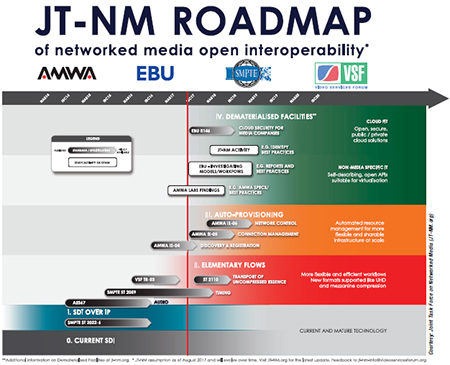What SMPTE-2110 Means for Broadcasters
AMSTERDAM—At last month’s IBC Show, SMPTE announced that three of the main documents in the new series of IP video standards (SMPTE ST 2110) have been finalized. Years of work have led up to this point, which should prove to be a pivotal moment in the ongoing migration of media networks to use IP networking technology. Once this new standard is fully released and implemented over the next few months, manufacturers will be able to supply devices that can seamlessly interconnect uncompressed video, audio and other important metadata between devices that support every conceivable video processing function.
WHY IP?
For broadcasters, the transition to Ethernet/IP technologies is inevitable for three main reasons:

The roadmap to an all-IP based media transport ecosystem, according to the Joint Task Force on Networked Media.
Flexibility — Today’s viewers are blessed with an enormous range of high-quality video content, most of which is available to watch on-demand using a variety of delivery networks and devices. Many of these systems already rely on IP networks to deliver content to the ultimate viewer; all of them use IP technology today at some point in the production process. With new video formats such as Ultra HD and high dynamic range coming to the fore today, and virtual/augmented reality just over the horizon, broadcasters need to replace their ageing SDI/HD-SDI production plants with a technology that has been proven to support multiple different formats on common infrastructure.
Cost — The cost of high-bandwidth IP equipment and circuits has been dropping steadily for several decades, a trend that shows no signs of stopping. Today, even low-cost workstations have GigE network connections built-in, and affordable 40 and 100 Gbps Ethernet switches are widely available. For connectivity, consumers are offered low-cost gigabit internet connections in many cities, and it is now possible to lease a 10 Gbps connection from London to New York for $2,500 per month (the same price that a 270 Mbps video connection would have cost just a few years ago with a thirtieth of the capacity).
Ubiquity — IP networks have been deployed everywhere that humans go today, including the International Space Station and Antarctica. Every smartphone user carries an IP send/receive device in their pocket. Videotape-based workflows have disappeared, replaced by workstations and storage systems that are dependent on high-speed Ethernet connectivity at the professional and the prosumer level.
THE IMPACT
The massive interop demonstrations that took place in 2016 and 2017 at IBC and the NAB Show have clearly shown the willingness of manufacturers to embrace IP technology. But what will be the impact on broadcasters? Here are a few changes that will be driven by the adoption of SMPTE ST 2110:
Get the TV Tech Newsletter
The professional video industry's #1 source for news, trends and product and tech information. Sign up below.
Common Timing — With bidirectional links throughout an IP-based facility, broadcasters will no longer need to construct separate signal paths to distribute sync signals to devices. Instead, IEEE 1588 Precision Time Protocol will allow devices to be slaved to a common master clock at accuracies of better than 1 microsecond, providing complete video and audio synchronization across an entire facility. When GPS receivers are added to the mix, separate facilities that are hundreds of miles apart can be frame-accurately synchronized and share a common timecode base.
Simplified Infrastructure — Anyone who has ever had to install something as simple as an audio system for a hotel ballroom has likely realized that cable management can quickly become a headache even for relatively simple setups, and adding video just makes the wiring more complicated. In large studios and OB vans, individual cable connections for each signal path can become congested, heavy and hard to maintain. Using high-speed Ethernet, a single connection can support multiple uncompressed HD video along with hundreds of uncompressed audio signals. As formats change in the future, only the end devices need to be upgraded, while the core IP equipment remains in place.
Reduced Bandwidths — Uncompressed 1080p video consumes 2.97 Gbps of bandwidth on a coaxial cable, which balloons up to 3.17 Gbps when converted to IP using SMPTE ST 2022-6 encapsulation. In contrast, a SMPTE ST 2110-20 signal with 1080p video occupies less than 2.67 Gbps, which frees up about 300 Mbps of bandwidth, which is almost enough capacity to carry one hundred audio signals. By sending only the image pixels (stripping off the legacy vertical and horizontal blanking/ancillary data spaces), the new standard moves to a system of only sending elementary signals, and removing the need for audio and metadata embedding and de-embedding. For lower-third graphics and other signals that occupy only a fraction of a video frame, the IP signal bandwidths are even lower.
Improved Versatility — SMPTE ST 2110 includes a robust mechanism for defining a wide range of video formats (up to 32,767 pixels on up to 32,767 lines), including multiple bit depths, multiple colorimetry schemes, any conceivable frame rate, and other associated parameters. Separating the transport format (Ethernet data frames carrying IP packets) from the video format gives broadcasters the ability to choose exactly the right format they need at each step along the broadcast chain, whether it is UHD for mastering or low-resolution video for streaming, and still be able to transport every version over a common infrastructure. As new applications emerge, new standards can easily be created to work in harmony with these established principles.
SMPTE ST 2110 is made up of a number of separate documents, each of which forms a part of the overall specification. ST 2110-10 gives a system overview and discusses system synchronization. ST 2110-20 details the uncompressed video formats, and the related ST 2110-21 defines how the torrents of packets needed to carry an uncompressed video signal will be managed to ensure that they don’t cause excessive flooding on a network. ST 2110-30 focuses on uncompressed PCM audio, and ST 2110-40 shows how the all-important metadata can also be carried over IP networks. Each of these standards is a topic in itself, and each will be discussed in detail in these pages in the coming months.
Wes Simpson is President of Telecom Product Consulting, an independent consulting firm that focuses on video and telecommunications products. He has 30 years experience in the design, development and marketing of products for telecommunication applications. He is a frequent speaker at industry events such as IBC, NAB and VidTrans and is author of the book Video Over IP and a frequent contributor to TV Tech. Wes is a founding member of the Video Services Forum.

